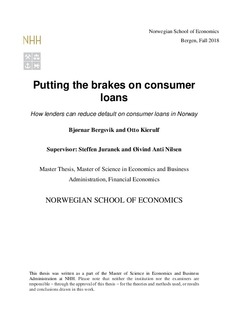Putting the brakes on consumer loans : how lenders can reduce default on consumer loans in Norway
Master thesis
Permanent lenke
http://hdl.handle.net/11250/2585551Utgivelsesdato
2018Metadata
Vis full innførselSamlinger
- Master Thesis [4372]
Sammendrag
In this thesis, we provide a method for lenders to reduce defaults on consumer loans in the Norwegian market. Using a dataset of 10 836 loans provided by a Norwegian consumer bank, we compare the characteristics of the loan takers and the loans and build two models for predicting probability of default.
By studying the characteristics of the loan takers and the loans, we want to see if appropriate to use for predicting defaults. We do this by comparing the defaulting loans with the non-defaulting, to see if any differences exist. Looking at both demographic and financial characteristics, we also find that certain groups of the population are more likely to default. Evidence suggest that this is particularly true for people under the age of 40 and people with an annual income less than 450 000 NOK. In contrast, our analysis shows that being married, having a master’s degree or being a private owner reduce the risk of default. We also see that a higher interest rate or more principal free months increase the risk of the loan. We conclude that the characteristics can be used for predictive purposes.
The purpose of the predictive models is to assist lenders in reducing defaults on future consumer loans. Based on stepwise backward selection, Mallow’s Cp and machine learning with Monte Carlo cross-validation, two logistic regression models are constructed. These models return predicted probability of default for a loan, using characteristics of the loan taker and the loan. The lender can utilize the models to ensure that no approved loans exceed the lender’s risk preference, by adjusting the attributes of the loan according to a desired threshold for probability of default. For instance, a probability threshold of 15 percent correctly predicted more than half of the defaulted loans.
In order to understand why the lender should try to reduce defaults, we also investigate why defaults occur in the market and what the financial consequences are. We conclude that lenders should reduce defaults to reduce costs, and that this can be done by adjusting the loans more properly to the loan takers. A general description of the market for consumer loans in Norway is also presented in order to give the reader a better understanding of the subject.
